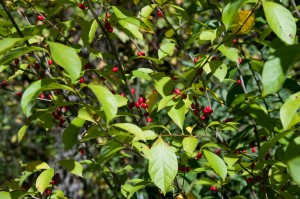U.S. native spicebush (Lindera benzoin) is a beautiful landscape plant (USDA hardiness zones 4-9) for an open or woodland garden. Spicebush matures into a 12-15 feet tall and wide large shrub or small tree over many years.
Light green deciduous leaves, 3 to 5 inches long, are delightfully fragrant when-crushed. Leaves is the preferred food for the larvae of the Spicebush swallowtail butterfly (Papilio troilus).
This dioecious shrub contributes a great deal of pleasure: aromatic foliage, showy autumn fruits, and lemony yellow fall color. The tiny 1/5 inch wide pale yellow flowers open in early spring and go mostly unnoticed during a time when showier shrubs and trees are also blooming. Female plants are ladened with 1/2 inch diameter berries that turn from green to yellow to glossy red. Fall red ripe berries quickly disappear, devoured by numerous birds and 4-legged fauna. Fall color rating varies from one year to the next and may be brightly yellow in good years.
Spicebush thrives in moist, well-drained, acidic soil and in full to partial shade. Initial growth rate is slow and gradually picks up in succeeding years. A multi-year old spicebush will naturalize in a moist or dry woodland site. Warning: spicebush tends to root sucker.
The spicebush swallowtail butterfly is endemic to the eastern US and southern Ontario. They are among the largest butterflies in the world. Spicebush swallowtail adults (butterflies) nourish themselves on nectar filled garden flowers and lay her eggs on spicebush foliage. Eggs hatch and the brown caterpillar larvae feed on the spicebush leaves.


 Posted in
Posted in 
